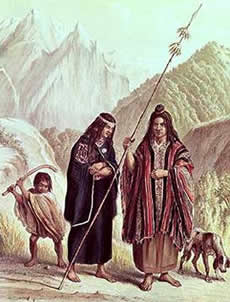Araucanian Indians
 |
| Araucanian Indians |
Occupying the western slopes of the Andes in the fertile lands between roughly 30 and 43 degrees south latitude, the Araucanians were loosely incorporated into the Inca realm in the late 1400s, though Inca influence was never strong.
Sedentary agriculturalists who cultivated corn, beans, and other crops, the Araucanians were less a unified polity than a series of independent chieftaincies sharing the same language and broadly similar social and cultural attributes.
The first Spanish incursion into the area, led by Diego de Almagro in 1535–37, met with bitter disappointment. The second, led by Pedro de Valdivia beginning in 1540, was nominally more successful. In 1541, Valdivia founded Santiago and a number of lesser settlements. After returning to Peru in 1547 and helping suppress the rebellion of Gonzalo Pizarro, Valdivia was named governor of Chile.
  |   |
From 1549, he continued his effort to conquer the Araucanians, marching south to the BÃo-BÃo River and founding the fortress-towns of Concepción (1550) and Valdivia (1552). Dividing subjugated Indians into encomiendas and heartened by reports of large deposits of gold, Valdivia encouraged miners and prospectors to stream into the district.
In 1553, a large force of Araucanians from the province of Tucapel and under the leadership of the chieftains Lautaro and Caupolicán launched a counterattack that annihilated an entire Spanish expedition, including Governor Valdivia, whom they ate in ritual cannibalism. A general uprising continued for four years. Their exploits were immortalized in the epic poem La Araucana (pub. 1569–89) by the Spanish poet Alonso de Ercilla y Zúñiga.
A brutal war followed. In 1598, victorious Araucanians captured and ate Governor MartÃn GarcÃa de Loyola. By 1600, the successors of Lautaro and Caupolicán had destroyed most of the nascent Spanish settlements south of the BÃo-BÃo.
Over the next two centuries, there emerged a complex military and political struggle, as the Spanish settlements slowly grew and groups of Araucanians rose in major uprisings in 1723, 1740, and 1776.
Scholars have emphasized the internal transformations in Araucanian culture, politics, and militarism, and the role played by Spanish deserters, as key to their long success in resisting Spanish domination. They were not militarily conquered until 1883, while their cultural influence remains strong in Chile today.
- Diego De Almagro
Diego de AlmagroA leading figure in the conquest of Peru Diego de Almagro launched a rebellion against the Pizarro brothers around Cuzco that convulsed the newly conquered Andean territories in civil war (1537–38) and led to his own death by garroting...
- Conquest Of Northwestern South America
Conquest of Northwestern South America Before the Spanish invasions of the early 16th century, the indigenous peoples of the Caribbean littoral of northern South America were divided into a number of polities and a host of ethnolinguistic groups. Their...
- History Of Uruguay
History of Uruguay. This is a short but informative overview to the history of the South American nation of Uruguay. From the site: The only inhabitants of Uruguay before European colonization of the area were the Charrua Indians, a small tribe driven...
- History Of Peru
History of Peru. This is brief but well written overview to the history of the South American nation of Peru. From the site: When the Spanish landed in 1531, Peru's territory was the nucleus of the highly developed Inca civilization. Centered...
- History Of Chile
History of Chile. Offers a brief and interesting history of this South American nation. From the site: About 10,000 years ago, migrating Indians settled in fertile valleys and along the coast of what is now Chile. The Incas briefly extended their...
